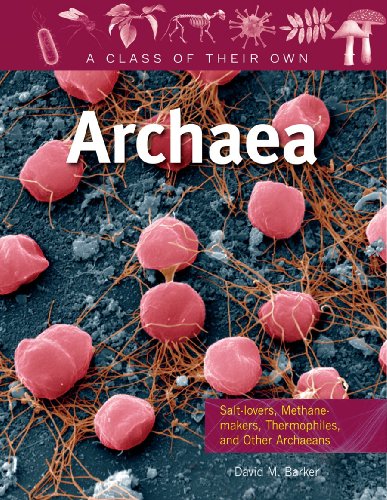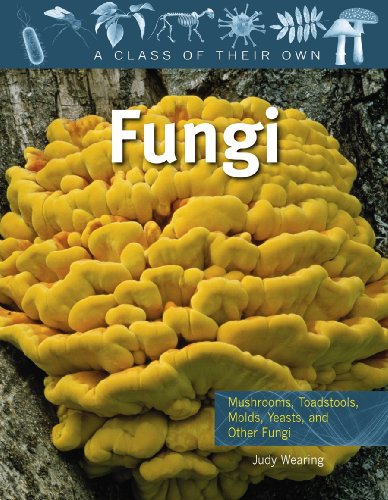-
Protists: Algae, Amoebas, Plankton, and Other Protists
Rona Arato
Paperback (Crabtree Publishing Company, Feb. 1, 2010)The kingdom Protista includes organisms, most of them microscopic, which have both animal and plant features. With such a diversity of life forms in this grouping, the features of this kingdom are quite varied. This intriguing book shows how this group's unusal members are generally classified according to an absence of a feature, such as the lack of complicated cell structure. Learn about such exotic organisms as algae, dinoflagellates, radiolarians, amoebae, and slime moldsall of them protists. Case histories examine the importance of plankton to the marine food chains, innovative uses of protists by humans, and the role of protists in various diseases. R
R
-
Bacteria: Staph, Strep, Clostridium, and Other Bacteria
Judy Wearing
Paperback (Crabtree Publishing Company, Feb. 1, 2010)Bacteria are microscopic organisms with a cell structure that is very different from that of the other kingdoms. Traditionally classified according to their shape, scientists now use DNA studies to refine the groupings of bacteria. This book examines bacteria that are found in virtually every environmentincluding those that are characterized by extreme heat, cold, and depthand, of course, bacteria that are found inside our bodies. Intriguing information highlights the key role that bacteria play in shaping the ecology of our planet, how some bacteria make their own food while others feed on ready-made food, and how some do indeed cause disease, while most do not. Case studies examine the development of new vaccines against bacterial diseases and the use of bacteria to help fight pollution. R
R
-
Animals: Mammals, Birds, Reptiles, Amphibians, Fish and Other Animals
Shar Levine, Leslie Johnstone
Paperback (Crabtree Pub Co, Feb. 15, 2010)Looks at the animal kingdom, providing information and examples of species from the major phyla and classes, as well as case histories of newly discovered endangered species. R
R
-
Archaea: Salt-Lovers, Methane-Makers, Thermophiles, and Other Archaeans
David M Barker
Paperback (Crabtree Publishing Company, Feb. 1, 2010)Some Archaea thrive in extreme places around the planet such as in thermal pools, hot vents at the bottom of the sea, extremely salty water, and even in underground oil reserves. Others are found in the intestines of animals and in plankton, tiny organisms that form a feeding reserve for larger marine life. Once grouped with bacteria, the DNA of this fascinating group is sufficiently different that scientists have proposed that they should have a sixth kingdom of their own. This book examines the three main divisions into which members of the diverse Archaea kingdom are grouped according to their unusual biology. It also explains why little in general is known about them, and why further classification of Archaea is so difficult. R
R
-
Plants: Flowering Plants, Ferns, Mosses, and Other Plants
Shar Levine, Leslie Johnstone
Paperback (Crabtree Publishing Company, Feb. 1, 2010)The plant kingdom contains more than 250,000 species. With green pigment called chlorophyll in some cells, these organisms have the unique ablility to make their own food. This colorful book describes the main groups of plants, including mosses, ferns, conifers, and flowering plants. Special sections highlight the role of plants in the environmentas producers in the food chain and producers of the worlds oxygenand their role in climate and the water cycle. Case histories include the discovery of a new species of conifer tree in Australia and special cases of plant breeding. R
R
-
Fungi: Mushrooms, Toadstools, Molds, Yeasts, and Other Fungi
Judy Wearing
Library Binding (Crabtree Publishing Company, Feb. 1, 2010)There are hundreds of thousands of different known fungi with many still to be discovered and developed. This interesting book features an examination of the four major groups: yeasts, toadstools, chytrids, and bread molds. Key characteristics of fungi are highlighted, such as spore production, fungis need to feed, and their use of long, branching cells known as hyphae to absorb nutrients from the environment. Special sections explore such varieties as saprophytes, which feed on dead and decaying matter; parasites, which often do considerable harm to other species; and species that form mutualistic relationships with other species to form composite organisms, such as lichen. Case histories involving fungi include penicillin and the fight against disease, and genetically modified (GM) products in food technology. R
R
-
Protists: Algae, Amoebas, Plankton, and Other Protists
Rona Arato
Library Binding (Crabtree Pub Co, Feb. 15, 2010)The kingdom Protista includes organisms, most of them microscopic, which have both animal and plant features. With such a diversity of life forms in this grouping, the features of this kingdom are quite varied. This intriguing book shows how this group's unusal members are generally classified according to an absence of a feature, such as the lack of complicated cell structure. Learn about such exotic organisms as algae, dinoflagellates, radiolarians, amoebae, and slime moldsall of them protists. Case histories examine the importance of plankton to the marine food chains, innovative uses of protists by humans, and the role of protists in various diseases. Y
Y
-
Animals: Mammals, Birds, Reptiles, Amphibians, Fish, and Other Animals
Shar Levine, Leslie Johnstone
Library Binding (Crabtree Pub Co, Feb. 15, 2010)How in the world do you classify the more than one million species in the animal kingdom? This fact-packed book divides animals into the major phyla, including chordates, arthropods, and mollusks; the major classes, such as fish, amphibians, reptiles, birds, mammals, and insects; and by critical features, such as cell structure and the need to feed. Fascinating case histories examine the discovery of new mammal species, the need to conserve endangered species, and using natural predators to control populations and preserve species and their environments. Special sections also highlight the relationships of animals with plants (food chains), bacteria (diseases), and Archaea (non-bacterial microorganisms found in the intestines of some animals). R
R
-
Fungi: Mushrooms, Toadstools, Molds, Yeasts, and Other Fungi
Judy Wearing
Paperback (Crabtree Publishing Company, Feb. 1, 2010)There are hundreds of thousands of different known fungi with many still to be discovered and developed. This interesting book features an examination of the four major groups: yeasts, toadstools, chytrids, and bread molds. Key characteristics of fungi are highlighted, such as spore production, fungis need to feed, and their use of long, branching cells known as hyphae to absorb nutrients from the environment. Special sections explore such varieties as saprophytes, which feed on dead and decaying matter; parasites, which often do considerable harm to other species; and species that form mutualistic relationships with other species to form composite organisms, such as lichen. Case histories involving fungi include penicillin and the fight against disease, and genetically modified (GM) products in food technology. R
R
-
Bacteria: Staph, Strep, Clostridium, and Other Bacteria
Judy Wearing
Library Binding (Crabtree Publishing Company, Feb. 1, 2010)Bacteria are microscopic organisms with a cell structure that is very different from that of the other kingdoms. Traditionally classified according to their shape, scientists now use DNA studies to refine the groupings of bacteria. This book examines bacteria that are found in virtually every environmentincluding those that are characterized by extreme heat, cold, and depthand, of course, bacteria that are found inside our bodies. Intriguing information highlights the key role that bacteria play in shaping the ecology of our planet, how some bacteria make their own food while others feed on ready-made food, and how some do indeed cause disease, while most do not. Case studies examine the development of new vaccines against bacterial diseases and the use of bacteria to help fight pollution. Y
Y
-
Archaea: Salt-Lovers, Methane-Makers, Thermophiles, and Other Archaeans
David M Barker
Library Binding (Crabtree Publishing Company, Feb. 1, 2010)Some Archaea thrive in extreme places around the planet such as in thermal pools, hot vents at the bottom of the sea, extremely salty water, and even in underground oil reserves. Others are found in the intestines of animals and in plankton, tiny organisms that form a feeding reserve for larger marine life. Once grouped with bacteria, the DNA of this fascinating group is sufficiently different that scientists have proposed that they should have a sixth kingdom of their own. This book examines the three main divisions into which members of the diverse Archaea kingdom are grouped according to their unusual biology. It also explains why little in general is known about them, and why further classification of Archaea is so difficult. R
R
-
Plants: Flowering Plants, Ferns, Mosses, and Other Plants
Shar Levine, Leslie Johnstone
Library Binding (Crabtree Publishing Company, Feb. 1, 2010)The plant kingdom contains more than 250,000 species. With green pigment called chlorophyll in some cells, these organisms have the unique ablility to make their own food. This colorful book describes the main groups of plants, including mosses, ferns, conifers, and flowering plants. Special sections highlight the role of plants in the environmentas producers in the food chain and producers of the worlds oxygenand their role in climate and the water cycle. Case histories include the discovery of a new species of conifer tree in Australia and special cases of plant breeding. Y
Y